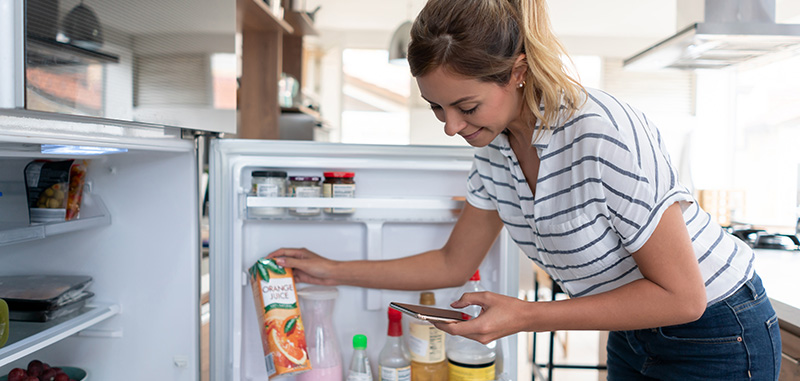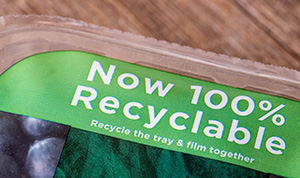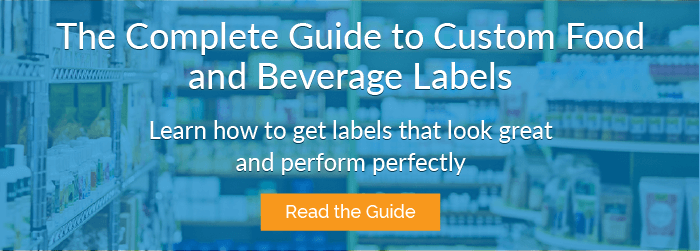
If you haven’t refreshed your food product labels in a while, 2022 is the year to do it. Events of the past few years have reshaped the global economy and radically altered how people buy food and beverages—and what they buy. At this point, it’s unlikely that things will ever go back to “normal,” even as the pandemic fades into the background.
To remain competitive, attract new buyers, and grow in this new reality, food and beverage brands must rethink how they present themselves to the world. And that starts with your most visible branding element: your product labels.
Here are three current economic trends destined to permanently alter the food and beverage buying landscape, along with tips on how to adapt your food product labels accordingly:
1. Scarcity and Inflation Inspiring Consumers to Try New Brands
As of this writing, the average 60-ounce container of orange juice costs 21 cents more than it did a year ago. A pound of fresh ground beef costs 82 cents more. And 16 ounces of bacon will cost you $1.24 more than it would have last year. According to the USDA, the Consumer Price Index for grocery store purchases increased 7.4% between January 2021 and January 2022. Inflation is hitting groceries hard, and consumers are feeling it.
Related to inflation (and a possible cause) are worldwide supply chain disruptions that have led to shortages affecting all kinds of food and beverage products. For example, in December, cream cheese was in such short supply Kraft Heinz offered to reimburse consumers $20 for not using the brand’s Philadelphia cream cheese to make cheesecake.
With prices climbing and store inventory spotty, many consumers are considering alternatives to their favorite brands. Affordable private label brands (aka store brands), especially, are having a moment. About 30% of consumers have switched to private label brands during the COVID pandemic, McKinsey reports.
Meanwhile, smaller regional or local brands that rely less on nationwide supply chains have an opportunity to swoop in and claim customers from the name brands. Just ask the makers of the Real Philly Schmear, an artisanal cream-cheese maker. Business has been booming since their industrial competitors started coming up short.
Adapting Your Food Product Labels for New Shopping Trends
Food and beverage buyers in 2022 are looking for quality products at affordable prices. But don’t expect to win new customers just by costing less or being in stock. First impressions still matter. Attractive packaging and cohesive, thoughtful branding have helped create cult followings for private labels from stores like Target, Trader Joe’s and of course, Costco.
The key is to offer value with a brand commitment to quality, so customers feel confident taking a risk on a smaller or lower-priced brand. Fortunately, distinctive product label design can convey this. For design inspiration, be sure to browse the rundowns of our favorite food and beverage label designs in categories including coffee, hot sauce, beer, and kombucha.
Also, consider making your branding more prominent on labels for food products like produce, instead of relying solely on the small UPC code stickers. Branded greens are increasingly popular, especially among millennials and the members of Generation Z. One study found that 68% of consumers will pay more for branded products. These young consumers connect with stories and brands that align with their values. Use your product label to tout your brand’s freshness, purity, or local origins (more on this in a moment).
Related Reading: Want to learn more about the label design process? Don’t miss our brand-new resource, the Guide to Product Label Design.
2. Grocery Shopping Online Has Been Normalized
Just a few years ago, food and beverages were among the few product categories largely untouched by e-commerce. Then the pandemic happened, and suddenly, everyone was buying groceries online.
Nearly 60% of Americans bought groceries online during the COVID pandemic—and it’s likely the habit will stick. Industry publication Supermarket News says online grocery shopping is “here to stay” and will account for 20% of the U.S. grocery market by 2026.
People like shopping for groceries online for the same reason they shop for electronics, clothes and everything else online: convenience. People like choosing their groceries in the relative calm of their homes and picking them up or having them delivered.
How to Adapt Your Food Product Labels for E-commerce
What sells on store shelves may have a harder time getting attention online. The difference is a matter of resolution. Many people shop for their groceries using their mobile devices … where fine details and tiny text can get lost.
A busy food product label design may come off as muddy on mobile screens. A cleaner look, using a few bold colors, may get your message across more effectively.
Keep in mind: only about 20% of online shoppers read product descriptions, so your product’s appearance really does matter. Think carefully about what you want your label to say about your brand and work with a skilled label designer and experienced label printer to make your vision a reality.
Online grocery shoppers who can’t inspect items in stores also want to be sure their purchases haven’t been tampered with—especially since COVID heightened the public’s hygiene awareness. Tamper-evident labels can provide your customers the reassurance they seek, inspiring trust in your brand.
3. Value-Based Gen-Z Consumers Prefer Sustainable Food Products
The oldest members of Generation Z (those born between 1997 and 2012) are reaching their mid-20s and becoming a market force that food and beverage brands must reckon with.
According to a 2021 report, Gen Zers’ top spending priority is food. The average teen spends 1,000 hours thinking about food, another study says—and it’s not just because they’re seemingly always hungry. Many of them have sustainability on their minds.
- 62% of Gen Zers—along with millennials—are more likely to spend more on food that doesn’t hurt animals or the environment.
- 25% of Gen Zers and 32% of millennials say they almost always or usually make food choices based on sustainability.
- According to a 2021 Deloitte survey, climate change/protecting the environment was the number-one concern for Generation Z.
How to Adapt Your Food Product Labels for Eco-Conscious Gen Zers
 To attract the members of Generation Z and millennials, feature your brand’s sustainability bona fides front and center on your product label.
To attract the members of Generation Z and millennials, feature your brand’s sustainability bona fides front and center on your product label.Consumers of all ages scrutinize product labels to learn about your brand’s values. Younger buyers, in particular, want to know where your ingredients come from and how your company contributes to certain ethical goals, such as sustainable agriculture, supporting local growers and treating animals humanely.
To attract the members of Generation Z and millennials, feature your brand’s sustainability bona fides front and center on your product label. One way to do this is with voluntary certification symbols, such as the Non-GMO Project seal and Fair Trade certification. You can also use QR codes or other smart label technology to direct consumers to your brand’s sustainability story online.
Many Gen Zers are also concerned about the environmental impact of product packaging and will choose food and beverage brands that share their concerns. Speak to your label printer about eco-friendly label options. Your printer might recommend options such as:
- Slimming down your label to conserve materials.
- Choosing sustainable label materials such as FSC-certified paper.
- Removable labels to promote reuse, recycling, or composting.
- Reducing label liner waste by using thinner liners or participating in a liner collection and recycling program.
Food Product Labels Should Evolve … But Some Things Are Classic
While consumer habits are constantly evolving, some food product label fundamentals are as important in 2022 as they were last century.
For example, label durability matters. And an experienced, expert label printer can be an invaluable partner. Familiarize yourself with the label buying and design basics by reading our free Complete Guide to Custom Food and Beverage Labels.

